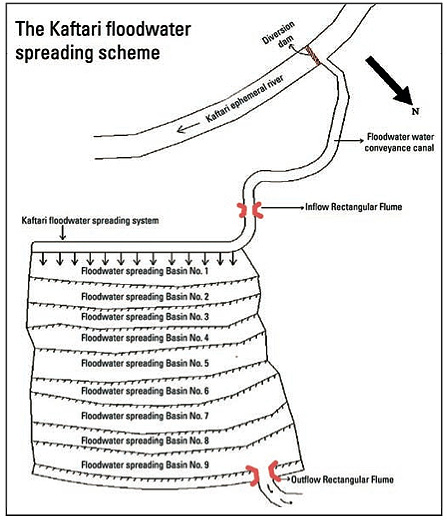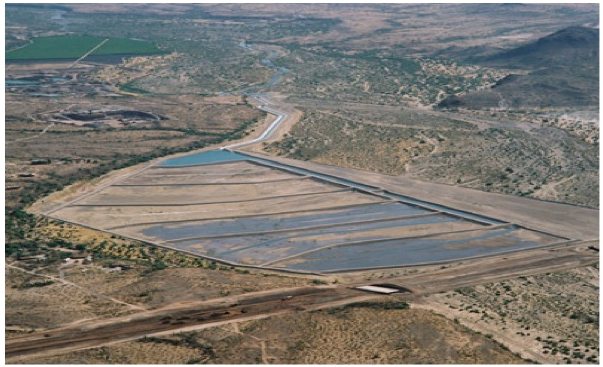Difference between revisions of "洪水控制/疏导水池"
Weichen Chen (talk | contribs) (→Construction, operations and maintenance) |
Weichen Chen (talk | contribs) (→Pre-construction considerations) |
||
| Line 42: | Line 42: | ||
* 如果通过控制洪水进行灌溉,农民应该更积极地参与开发改进防洪系统,新系统应该在现有方法和土地权的基础上改进,而不是像过去那样破坏或违反。 | * 如果通过控制洪水进行灌溉,农民应该更积极地参与开发改进防洪系统,新系统应该在现有方法和土地权的基础上改进,而不是像过去那样破坏或违反。 | ||
| − | ==== | + | ====修建前的考虑==== |
| − | + | 洪水多变,因此很难用传统的降雨径流模式预测,因为降雨通常不与流入防洪系统的季节性河流的径流相关。为抵挡凶猛洪水而修建大规模永久性的引水建筑物造价太高,而且仍可能遭到破坏并出现淤积现象。虽然,淤积能带来营养物质,但同时也会对洪水灌溉造成一个严重问题——季节性河流中的沉淀物大约占3%-10%,沉淀物小有泥沙,大有巨砾。泥沙会堵塞管道,抬高耕地并导致河道改道,从而错过引水建筑物。大量的漂浮物也会导致流入量出问题。 | |
| − | + | 以下有五点建议: | |
| − | * | + | * 洪水过后,重建该系统的某些部分比设计更持久的引水建筑物要更划算。传统的引水建筑物不仅效果更好,而且费用比其他方式低得多。它能分隔洪水(泥沙淤积严重的河水不会流向陆地)。 |
| − | * | + | * 改进河水分流并保持土壤水分比仅仅提高引水建筑物的效率更有益处 (请参阅 [[堤岸]])。应该在还没有普及这个方法的地方进行推广。 |
| − | * | + | * 由于洪水极不稳定,因此需要改变传统的系统使其更加灵活。在过去,洪水灌溉的灵活性体现在农民身上,他们随时需要转移到其他地方。 |
| − | * | + | * 逐渐加固现有的传统流入量证实与大规模干预同样划算,并且比后者效果更好。 |
| − | * | + | * 没有闸门的简易引水建筑物由石笼、碎石砌墙或混凝土建成。农民十分熟悉这种方法,因此更容易进行维护。限制流量的引水建筑物和溢洪道需要在运河的上游,以防止洪流损坏运河和灌溉设施。 |
====Operations and maintenance==== | ====Operations and maintenance==== | ||
Revision as of 04:43, 28 August 2015
这是一项利用洪水的技术,通过修建引水建筑物和运河将河水疏导至一大片区域,从而补给地下水和池塘、灌溉土地和牧场。这个技术的原理是当少量的水以最慢的速度流过土地时不会破坏土壤表面。这包括漫灌,也包括通过运河将河水疏导至田地的标准灌溉渠方法。
适宜条件
水流量大、水流湍急,并且不适合传统灌溉方式的地方(漫灌系统应该在已经应用的地方大力推广)。
| 优势 | 劣势 |
|---|---|
| - 不需要对土地进行太多准备,因此比其它渗入方式性价比更高 - 大部分河流中的沉淀物(如70%)会沉淀在土地上,有益于农业 |
- 需要大面积的土地 - 季节性河流的水量在时间和流量上难以预计,这将导致无法预计水流在土地上的流经面积,并会对这种方式造成损害 |
应对环境变化的适应性
干旱
干旱的后果: 农作物产量降低
潜在的原因: 灌溉农作物的洪水量减少
增加 WASH 系统的适应性: 防旱且生长周期短的作物;使农民种植的作物具有多样性
关于治理干旱的更多信息,请查看: 易干旱地区具有适应性的WASH系统。
洪水
疏导水池对于洪水多发地区十分有益。这样可以将多余的河水转移走,由此控制洪水。然而在洪水泛滥的地区,盆地必须足够大才能应对增大的雨量。另外,在降雨集中的时候,水流速度可能太快,以导致土壤被冲刷,或有可能水还没来得及渗入到地下就流走了。因此在这种情况下,增加植被(帮助土壤吸收更多水分)、增加湿地、保护防洪堤以及/或增加储水量都会很有益处。
修建、运作和维护
关于水泥的建议: 建筑和隔板(例如水箱、大坝、水道和水井)出现裂缝的常见原因是在混合和使用水泥时出错。首先,很重要的一点是使用的成分一定要纯:干净的水、沙子和岩石,这些成分必须充分混合。第二,混合时所需的水量极少:混凝土或水泥成形即可,宁可干点,也不要成为液体。第三,在固化过程中混凝土或水泥需要有一定的水分,至少维持一周。同时,引水建筑物应该用塑料、大树叶或其他材料覆盖以保持水分。
具体建议:
- 最好将精力集中在低成本的引水建筑物上,从而避免使用复杂的技术方法。重点应在提高现有的流入量。
- 如果通过控制洪水进行灌溉,农民应该更积极地参与开发改进防洪系统,新系统应该在现有方法和土地权的基础上改进,而不是像过去那样破坏或违反。
修建前的考虑
洪水多变,因此很难用传统的降雨径流模式预测,因为降雨通常不与流入防洪系统的季节性河流的径流相关。为抵挡凶猛洪水而修建大规模永久性的引水建筑物造价太高,而且仍可能遭到破坏并出现淤积现象。虽然,淤积能带来营养物质,但同时也会对洪水灌溉造成一个严重问题——季节性河流中的沉淀物大约占3%-10%,沉淀物小有泥沙,大有巨砾。泥沙会堵塞管道,抬高耕地并导致河道改道,从而错过引水建筑物。大量的漂浮物也会导致流入量出问题。
以下有五点建议:
- 洪水过后,重建该系统的某些部分比设计更持久的引水建筑物要更划算。传统的引水建筑物不仅效果更好,而且费用比其他方式低得多。它能分隔洪水(泥沙淤积严重的河水不会流向陆地)。
- 改进河水分流并保持土壤水分比仅仅提高引水建筑物的效率更有益处 (请参阅 堤岸)。应该在还没有普及这个方法的地方进行推广。
- 由于洪水极不稳定,因此需要改变传统的系统使其更加灵活。在过去,洪水灌溉的灵活性体现在农民身上,他们随时需要转移到其他地方。
- 逐渐加固现有的传统流入量证实与大规模干预同样划算,并且比后者效果更好。
- 没有闸门的简易引水建筑物由石笼、碎石砌墙或混凝土建成。农民十分熟悉这种方法,因此更容易进行维护。限制流量的引水建筑物和溢洪道需要在运河的上游,以防止洪流损坏运河和灌溉设施。
Operations and maintenance
Systems should be self-reliant with regards to routine operation and repair, but some backstopping from public sector units is a good idea:
- Spate systems rely on communal management and dialogue due to their scale. Projects should not attempt to unnecessarily formalize agreements for maintenance – farmers should be the drivers for this. However, any user associations should be based on catchments or communally-used areas.
- Provision of bulldozers has been very popular and has enabled spate farmers to build or restore damaged structures more easily. Problems with that is that sometimes downstream effects become too great since farmers upstream can build much larger structures, and also that bulldozers cannot easily be run and maintained in a self-sustaining fashion due to high costs. Support is therefore too large for small farmer groups and is best organized on a regional basis through local government, or with subsidies to allow participation of the private sector.
Field experiences

Drawing: Strategies for Managed Aquifer Recharge (MAR) in semi-arid areas. UNESCO.
Iran
Overexploitation of groundwater has caused significant drawdown of the water table (1.5m/year) and deterioration of groundwater quality in the Dorz Sayban Plain, which is located 115 km to the southeast of Larestan, Iran. 3500 hectares of land are irrigated using groundwater in this plain. To decrease the rate of the drawdown of the water table, five floodwater spreading systems for recharge of groundwater were designed and constructed in the region 1983 and 2001.
Inflow and outflow rates from the Kaftari floodwater spreading system were measured for nine flooding events during 2002-2003 using rectangular flumes in the system. The maximum inflow and outflow rates in the system were 20.3 and 7.26 m3/s, respectively. The total volume of inflow and outflow of the system was about 886,000 and 146,000 m3 for the nine flooding events. Therefore, 83.5% of the inflow to the system was recharged to the aquifer, only small quantities being lost to evaporation. This shows the high performance of floodwater spreading systems in the recharge of groundwater.
More than 70% of the suspended load has settled in the system. This will inevitably lead to clogging and reduction in efficiency in the system, but also an improvement of the soil for agriculture purposes. Additionally, the managed aquifer recharge improves the quality of groundwater, as the EC of floodwater is much lower than that of the groundwater (0.3-0.4 versus 2.0-9.0 dS/m).
Manuals, operations and maintenance
- Sustainable Development of Groundwater Resources in Southern and Eastern Africa. International Atomic Energy Agency.
Acknowledgements
- CARE Nederland, Desk Study: Resilient WASH systems in drought-prone areas. October 2010.
- Gale, Ian, Strategies for Managed Aquifer Recharge (MAR) in semi-arid areas. UNESCO's International Hydrological Programme (IHP), 2005.
- Address unknown future effects of climate change. Colusa County Resource Conservation District, USA.

